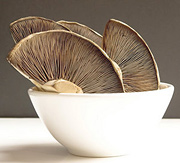Wild About Mushrooms
By Zhenya K. Wine
My childhood memories of my life in Russia include many summer and fall trips with family and friends to gather mushrooms, herbs and berries. It was a family tradition and something we all looked forward to doing together. However, there is an art to this foraging. It's important to know what to pick and how to preserve what you can't use immediately. But when the gathering is complete, we are blessed with the one of the most healing and delicious foods that nature produces.
Approximately 1.5 million fungi are found in the world - molds, fermenting bacteria, and other spores fall into this category - only 70,000 (5 percent) of this large species have been studied. Here I will outline the medicinal properties of four edible mushrooms: porcini, chanterelle, crimini and portabella. Some of these might grow in your area, but before eating any mushrooms you pick, I would recommend consulting your doctor/nutritionist or local mushroom club, since some mushrooms are quite poisonous. The mushrooms discussed here I purchase at a local store in a dried or fresh form and have been certified as ready for consumption.
Let's begin with two European mushrooms - . The king of mushrooms is known as (Latin) and is called in France, in Germany, and in Italy. In U.S. grocery stores, you most likely will see them referred to as porcini and they can be purchased either fresh or dried. When examining the porcini, you will see a mushroom with a large brown cap, fat stem, and a heavy and heavenly smell.
 When cutting this mushroom, observe the very white and slightly porous flesh. Although very delicious when cooked, this mushroom possesses incredible healing properties. According to Russian research done on its medicinal attributes, porcini is used as a medicinal remedy in the treatment of tuberculosis, general weakness, and to improve metabolic functions. Some of the Russian folk medicine writings that survived from the 1600s talk about the use of porcini extractions in treatments of hard-to-treat skin ulcerations and frost bite. An alkaloid found in it is used to treat cardiac angina. Beta-glucan, which is found in most mushrooms and is present in high concentrations in porcini, is instrumental in cardiovascular health and provides many other health benefits. In ancient times, it was believed that by eating porcini, you might be able to prevent intestinal dysfunctions.This has been proven true by research. Scientists have found oligosaccharide (a simple sugar) in cooked and raw porcini. The undigested parts of this sugar promote probiotic activity in the colon by stimulating growth of healthy bacteria.
When cutting this mushroom, observe the very white and slightly porous flesh. Although very delicious when cooked, this mushroom possesses incredible healing properties. According to Russian research done on its medicinal attributes, porcini is used as a medicinal remedy in the treatment of tuberculosis, general weakness, and to improve metabolic functions. Some of the Russian folk medicine writings that survived from the 1600s talk about the use of porcini extractions in treatments of hard-to-treat skin ulcerations and frost bite. An alkaloid found in it is used to treat cardiac angina. Beta-glucan, which is found in most mushrooms and is present in high concentrations in porcini, is instrumental in cardiovascular health and provides many other health benefits. In ancient times, it was believed that by eating porcini, you might be able to prevent intestinal dysfunctions.This has been proven true by research. Scientists have found oligosaccharide (a simple sugar) in cooked and raw porcini. The undigested parts of this sugar promote probiotic activity in the colon by stimulating growth of healthy bacteria.
The leading indication of the porcini mushroom is believed to be its influence in treatment and prevention of cancer. The Bohemian forests (not to be confused with The Black Forest) of Germany produce a specific variety of this mushroom in areas where it grows in a symbiotic relationship with white pine. After an in-depth cultural investigation, it was found that the population of this region has one of the lowest cancer occurrences, which was attributed to the Boletus mushroom found in the population's diet. The understanding is that the impressive presence of selenium, beta-glucan and L- ergothioneine in this mushroom is the reason for its anti-tumor activity.
This mushroom possesses the highest number of amino acids when compared to other mushrooms. Such essential and non-essential amino acids as L-leucine, tyrosine, arginine and glutamine are present in porcini at a rate of 14 percent to 37 percent. Potassium, calcium and phosphorus are present in the porcini at significant rates as well. Porcini also is one of the few mushrooms rich in vitamin D and other vitamins such as B1, B2 and C, as well as carotenoids that convert to vitamin A.

